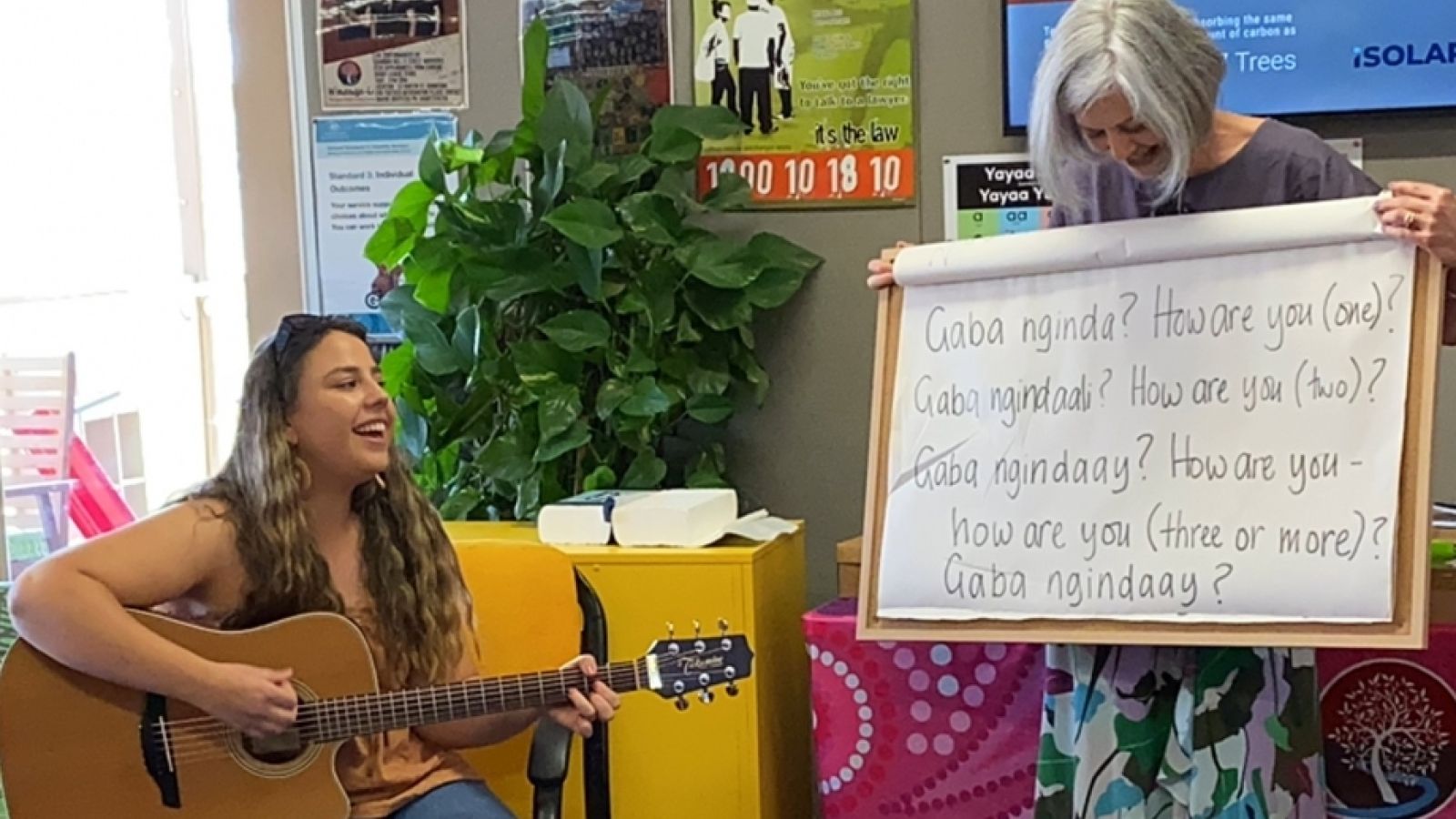Hear, read, watch Gamilaraay Voices

Dr Hilary Smith with Gamilaraay singer Loren Ryan who works with us on the Yaama Gamilaraay! project. Image: supplied.
By Evana Ho
A trio of ANU linguists, in collaboration with the Winanga-Li Aboriginal and Family Centre, have developed a set of resources for students at the Australian National University to support their learning of the Gamilaraay language and culture.
The resources, which are collectively called 'Gamilaraay Voices', build on the Gamilaraay language course taught at ANU by Dr John Giacon, who has been described as the leading descriptive linguist working on Gamilaraay. 'Gamilaraay Voices' comprises a series of 15 short videos that cover key issues in language loss, survival and renewal, and a booklet of supporting materials.
Applied linguist Dr Hilary Smith, an Honorary Senior Lecturer with the ANU School of Literature, Languages and Linguistics, led the project. She and Dr Giacon have been working with colleagues at Winanga-Li for the renewal of Gamilaraay language since 2016, where they provide support for the ‘Yaama Gamilaraay’ early childhood language project funded by the NSW Department of Education.
“Gamilaraay people are working to renew their language, and the perspectives presented in the materials help us to understand why this need has arisen, and the different approaches taken towards it,” Dr Smith explains.
“The videos allow the voices of Gamilaraay people to be heard and showcased online, benefiting many ANU students,” she says.
Dr Carmel O'Shannessy, Director of the project 'Gamilaraay Voices', has worked in Indigenous languages and education for over two decades.
“Through 'Gamilaraay Voices', we aim to bring a Gamilaraay cultural perspective to ANU languages and cultures courses, raise awareness within the ANU of Indigenous languages and cultures, and support the Gamilaraay people as language custodians,” Dr O'Shannessy says.
Gamilaraay country extends from northern inland NSW to adjoining southern Queensland. The 'Gamilaraay Voices' booklet quotes from the New South Wales Aboriginal Languages Act, passed in November 2017, which acknowledges that past Government decisions led the Gamilaraay language to becoming “almost lost”. The Gamilaraay people are actively working to renew the language, and there are now children and adults learning Gamilaraay.
The Winanga-Li Aboriginal and Family Centre plays an important role in this, and is striving to become the peak organisation for Gamilaraay language and culture in the region. Located in Gunnedah, approximately the centre of Gamilaraay country, it's one of nine centres in NSW established and funded as a Closing the Gap initiative under the Early Childhood Development National Partnership agreement. Winanga-Li is a Gamilaraay word which means “hear, listen, know, remember”.
Dr Smith says that Winanga-Li is a partner organisation of 'Gamilaraay Voices', and it contributed staff time, cultural expertise, connections and accommodation for the project team.
“Since the establishment of the centre, Winanga-Li has developed a range of successful programs working with Aboriginal families in the northwest region of New South Wales, and it's often approached by other organisations for advice on language and culture.”
“Wayne Griffiths explains in one video that it ‘makes the world of difference’ to hear children speaking Gamilaraay words, and that language renewal is ‘a new beginning’ for ‘an ancient story’,” says Dr O’Shannessy. “All of the speakers in the videos show that language renewal is a rich cultural practice that increases health and well-being in so many ways.”
'Gamilaraay Voices' was developed through the support of an ANU Linkage for Learning and Teaching Grant, the School of Literature, Languages and Linguistics, and the ARC Centre for Excellence in the Dynamics of Language. The resources can be found here: https://slll.cass.anu.edu.au/research/projects/gamilaraay-voices
Details about studying the undergraduate introduction to Gamilaraay course are available here: https://programsandcourses.anu.edu.au/2021/course/INDG2003